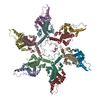+Search query
-Structure paper
| Title | Structure of the Hepatitis B virus capsid quasi-6-fold with a trapped C-terminal domain reveals capsid movements associated with domain exit. |
|---|---|
| Journal, issue, pages | J Biol Chem, Vol. 299, Issue 9, Page 105104, Year 2023 |
| Publish date | Jul 28, 2023 |
 Authors Authors | Christine Kim / Christopher J Schlicksup / Carolina Pérez-Segura / Jodi A Hadden-Perilla / Joseph Che-Yen Wang / Adam Zlotnick /  |
| PubMed Abstract | Many viruses undergo transient conformational change to surveil their environments for receptors and host factors. In Hepatitis B virus (HBV) infection, after the virus enters the cell, it is ...Many viruses undergo transient conformational change to surveil their environments for receptors and host factors. In Hepatitis B virus (HBV) infection, after the virus enters the cell, it is transported to the nucleus by interaction of the HBV capsid with an importin α/β complex. The interaction between virus and importins is mediated by nuclear localization signals on the capsid protein's C-terminal domain (CTD). However, CTDs are located inside the capsid. In this study, we asked where does a CTD exit the capsid, are all quasi-equivalent CTDs created equal, and does the capsid structure deform to facilitate CTD egress from the capsid? Here, we used Impβ as a tool to trap transiently exposed CTDs and examined this complex by cryo-electron microscopy. We examined an asymmetric reconstruction of a T = 4 icosahedral capsid and a focused reconstruction of a quasi-6-fold vertex (3.8 and 4.0 Å resolution, respectively). Both approaches showed that a subset of CTDs extended through a pore in the center of the quasi-6-fold complex. CTD egress was accompanied by enlargement of the pore and subtle changes in quaternary and tertiary structure of the quasi-6-fold. When compared to molecular dynamics simulations, structural changes were within the normal range of capsid flexibility. Although pore diameter was enlarged in the Impβ-bound reconstruction, simulations indicate that CTD egress does not exclusively depend on enlarged pores. In summary, we find that HBV surveillance of its environment by transient exposure of its CTD requires only modest conformational change of the capsid. |
 External links External links |  J Biol Chem / J Biol Chem /  PubMed:37517693 / PubMed:37517693 /  PubMed Central PubMed Central |
| Methods | EM (single particle) |
| Resolution | 4.0 - 4.2 Å |
| Structure data |  EMDB-40048: Empty HBV Cp183 capsid with importin-beta EMDB-40049: empty HBV Cp183 capsid with importin-beta, subparticle reconstruction at 2fold location |
| Source |
|
 Keywords Keywords |  VIRAL PROTEIN / HBV / Cp183 / Importin-beta VIRAL PROTEIN / HBV / Cp183 / Importin-beta |
 Movie
Movie Controller
Controller Structure viewers
Structure viewers About Yorodumi Papers
About Yorodumi Papers







